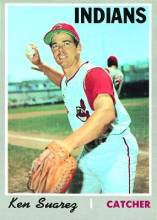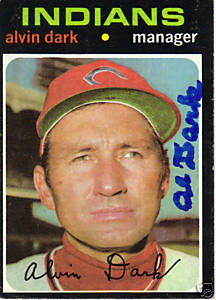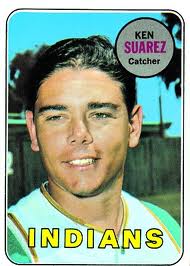 Indians Archive
Indians Archive  Tribe Game Vault: 5/16 and 5/17, 1970. An Indians Spy Tale from the Cold War Era
Tribe Game Vault: 5/16 and 5/17, 1970. An Indians Spy Tale from the Cold War Era
 The Cold War is thought to have begun in 1947. This was when the Soviets began to seize control of the Eastern Bloc countries it began to occupy prior to the end of World War II. But the political- if not military- tensions between the United States and the Soviet Union actually began during the war. Before the Soviets had ceased torturing German citizens on the 1945 march to Berlin, even.
The Cold War is thought to have begun in 1947. This was when the Soviets began to seize control of the Eastern Bloc countries it began to occupy prior to the end of World War II. But the political- if not military- tensions between the United States and the Soviet Union actually began during the war. Before the Soviets had ceased torturing German citizens on the 1945 march to Berlin, even.
The United States wished to ensure its peace and sovereignty through the widespread establishment of democratic countries, especially in Europe. The Soviets’ aim also was to preserve its own security- although they intended this goal to be accomplished through the expansion of their borders, in an ever-aggressive posture.
Since both sides possessed nuclear weapons (which could lead to Mutually Assured Destruction), they fought by proxy through several conflicts and ‘hot’ wars around the world, such as the one in Viet Nam through the ‘60s and into the ‘70s.
This ugly era in world history influenced countless aspects of everyday life, including sports. East Germany’s doping program was an attempt to assert Eastern sporting dominance. President Jimmy Carter led a boycott of the 1980 Summer Olympics in Moscow due to the refusal of the Soviets to withdraw from Afghanistan. Of course, the Soviets returned the favor, boycotting the 1984 Summer Olympics in Los Angeles.
There were uplifting moments from the Cold War era. An example was the 1980 U.S. Miracle on Ice. The young U.S. men’s hockey team beat the talented and experienced Soviets in a huge upset, on the way to defeating Finland for the Olympic gold medal.
Occasionally, a humorous story would emerge as a by-product of the era. Successful Soviet athletes were known to live very well- they were far better off than the citizenry at large. Since the athletes had an incentive not to ‘peak’ too early in their careers, there were whispers that some sports stars ‘sand-bagged’ their performances. That way, they could achieve increasing levels of success rather than perhaps set one world record and then spend the rest of their lives attempting to measure up to it. While they were improving, they remained in favor with the authorities. One notable athlete who was a rumored ‘sand-bagger’ (my word) was Sergey Bubka. He was a world-class pole vaulter through the 1970s, ‘80s and ‘90s. He went through a stretch of time where he was setting a new world record every couple months- about a hundredth of a meter at a time. Clevelanders got to witness some of this, in several of the indoor track meets Bubka participated in at the Richfield Coliseum. (Truth be told, it was pretty exciting at the time. There was some local hype, and the alternating anticipation and barrage of flash bulbs accompanying each jump created a lot of buzz during the meets.)
There was even a dash of the romantic woven into the Cold War, embodied by the spies employed by both sides.
The 'spy' thing has always been a part of major league baseball. Sure, there’s been the odd Ross Grimsley bat-retrieving escapade, but sign-stealing is baseball’s bread-and-butter method of espionage. I’ve never really understood the unwritten rules on that. For instance, it is definitely taboo for a batter to look in to the catcher to read signs. However, many teams have tried to steal signs using whistles, fake TV cameras in the outfield stands, buzzers wired from the bullpen to the dugout, and flashing lights on the scoreboard to signal the hitter. Tribe fans will recall that Bob Feller and Bob Lemon used Feller’s military telescopic gun sight from behind the outfield scoreboard at the Stadium in 1948 as the Tribe surged to the World Series Championship that season.
***
Let’s turn to a 1970 episode of 'spying' by the Cleveland Indians, in Boston’s Fenway Park. On Friday, May 15, the Tribe was 11-17, in 5th place and 10 games out of first. The Red Sox were suffering through a similar start to the season, entering play at 14-17.
Pitching for the Tribe was stud ace Sam McDowell, a power lefty who was ‘as talented as Koufax’ and would have had a Hall of Fame career if it weren’t for his drinking and drug addictions. 1970 was a dominant season for McDowell. Going for the Red Sox was a marginal starting pitcher by the name of Gary Peters.
The Indians drew blood in the top of the 1st inning. 2B Larry Brown and CF Ted Uhlaender each singled, and 1B Tony Horton doubled to left to score one. LF Chuck Hinton singled to plate the 2nd and 3rd runs. 3-0, Indians.
That, folks, was all McDowell needed- and it was all he got. He and Peters each pitched outstanding baseball; each went the distance and struck out eight. Sudden Sam allowed only three hits: one to CF Reggie Smith, one to RF Tony Conigliaro, and one to C Jerry Moses. The Tribe smacked ten hits off Peters, but after the first inning, never mounted much of a rally. Every Indians starter had at least one hit (even McDowell), except for RF Roy Foster (who struck out twice) and the fine rookie catcher, Ray Fosse (who unfortunately grounded into two double plays).
The next day’s matchup featured Wooster, Ohio native Dean Chance for the Indians against Boston’s Ray Culp. Neither team could score early. The Red Sox left two men on base in the 1st, and a one-out double play bailed Chance out of a bases-loaded jam in the 3rd.
In the Tribe 4th, RF Vada Pinson singled to right. After a fly out by LF Duke Sims (who had been the Tribe catcher prior to the arrival of Fosse), 3B Graig Nettles singled to center. With Fosse at bat, Pinson was picked off second base- only, the pitcher Culp threw the ball away. Pinson scored, and Nettles moved from first to third on the error. Fosse sacrificed Nettles home with a bunt. After 3 ½, Tribe 2, Red Sox 0. (Am I alone in my belief that everything a pitcher does to give away outs and allow runs should count in his ERA? Why should pitchers’ errors not count?)
That was all the scoring the Indians would do on this day. With Cleveland reliever Dennis Higgins on the mound, ‘Tony C’ of the Red Sox would homer in the 6th after a double by LF Carl Yastrzemski, and ‘Yaz’ would hit a three-run homer of his own in the 8th. By the time SS Rico Petrocelli homered in the 8th as well, the game was decided. Ray Culp got the complete-game win for Boston.
 So where’s the spy story? From 1968 through 1971, the Indians’ starting catchers were Joe Azcue, Duke Sims and Ray Fosse. One of the backup catchers was Ken Suarez. He was small for major league baseball, at 5’8” tall- but he made up for his lack of size with his effort and intelligence. He’d played high school baseball with Lou Piniella and Tony LaRussa, and Piniella has noted that Suarez was one of the smartest players he’d played with in his career. At the request of Indians manager Alvin Dark, Suarez became the Tribe’s sign stealer extraordinaire. He variously spied catchers’ signs from the bullpen or the grandstands,
So where’s the spy story? From 1968 through 1971, the Indians’ starting catchers were Joe Azcue, Duke Sims and Ray Fosse. One of the backup catchers was Ken Suarez. He was small for major league baseball, at 5’8” tall- but he made up for his lack of size with his effort and intelligence. He’d played high school baseball with Lou Piniella and Tony LaRussa, and Piniella has noted that Suarez was one of the smartest players he’d played with in his career. At the request of Indians manager Alvin Dark, Suarez became the Tribe’s sign stealer extraordinaire. He variously spied catchers’ signs from the bullpen or the grandstands,  and used several methods to relay the signs to the dugout.
and used several methods to relay the signs to the dugout.
In 1970, Suarez was out the entire season with a broken leg. He would often sit in the stands with his binoculars and perform his espionage for Dark.
During the Friday game we reviewed above, Suarez was in the Fenway bleachers. During the game*, he spotted two police officers who were looking around in his direction. Suarez surmised that they’d been tipped off to him. Suarez slipped away and hailed a taxi. He told the driver to take him to the train station. There, he rented a public locker and hid the binoculars. After the game was over, he returned to the train station and retrieved them.
*Judging by the lack of scoring by the Indians after the 1st inning, I am guessing he was spooked early in the game!
 Fast forward to the Saturday game. Red Sox manager Dick Williams was hot on the trail of Ken Suarez. First, the Indians discovered that Williams had ordered the phone line cut from the visitors’ dugout to their bullpen. He figured that was how signs were getting relayed, since the police officers didn’t see anyone in the bleachers stealing signs.
Fast forward to the Saturday game. Red Sox manager Dick Williams was hot on the trail of Ken Suarez. First, the Indians discovered that Williams had ordered the phone line cut from the visitors’ dugout to their bullpen. He figured that was how signs were getting relayed, since the police officers didn’t see anyone in the bleachers stealing signs.
After Suarez caught the pre-game warm up pitches from Dean Chance, he gathered his stuff and made the slow walk from the bullpen to the dugout. The binocular case was slung over his shoulder in a conspicuous manner. Flamboyant umpire Ron Luciano ran across the field to Suarez, and grabbed the binocular case. He knew he had Suarez dead to rights.
Suarez played the innocent, and gave up the case. Luciano opened it- only to find the four baseballs that Suarez had filled it with!
Thank you for reading.
Sources included baseball-reference.com, The Cleveland Indians Encyclopedia by Schneider, and Whatever Happened to Super Joe? Catching Up With 45 Good Old Guys from the Bad Old Days of the Cleveland Indians, Schneider.
- NBA Announces 2013-2014 Schedule
- Browns Ink Sharknado
- Sharknado A No-Show For Rookie Camp
- Trent Richardson Out Until Training Camp
- Browns Sign Brandon Jackson
- Carrasco Suspended Eight Games
- Browns Add to Wide Receiver Depth with David Nelson
- Browns Need to Learn from Past Draft Mistakes
- Browns Release Chris Gocong and Usama Young
- Browns Missing on Grimes Disappointing, But Not The End
The TCF Forums
- Chris Grant's first 3 drafts
Kingpin74 (Tuesday, January 21 2014 10:13 AM) - The 2014 Offseason Thread
googleeph2 (Tuesday, January 21 2014 9:36 AM) - 2015 Recruiting
furls (Tuesday, January 21 2014 6:57 AM) - Mike Brown
YahooFanChicago (Monday, January 20 2014 11:15 PM) - Movies coming out
HoodooMan (Monday, January 20 2014 9:34 PM) - 2014 Hoops Hockey Hijinx
jpd1224 (Monday, January 20 2014 4:44 PM) - 2014 Recruiting
jclvd_23 (Monday, January 20 2014 2:26 PM) - Wish List - #4 Pick
Hikohadon (Monday, January 20 2014 1:26 PM) - Official- Browns Coach Search/Rumors
OldDawg (Sunday, January 19 2014 6:48 PM) - #1 overall pick Anthony Bennett
TouchEmAllTime (Sunday, January 19 2014 1:28 PM)


